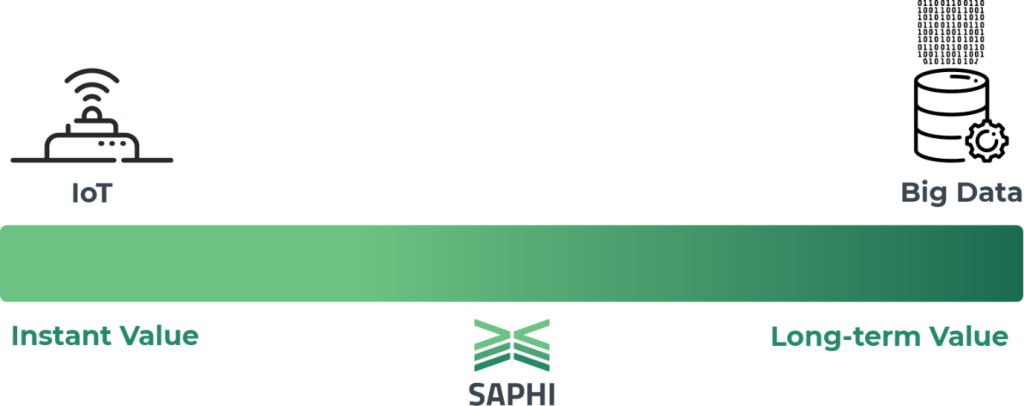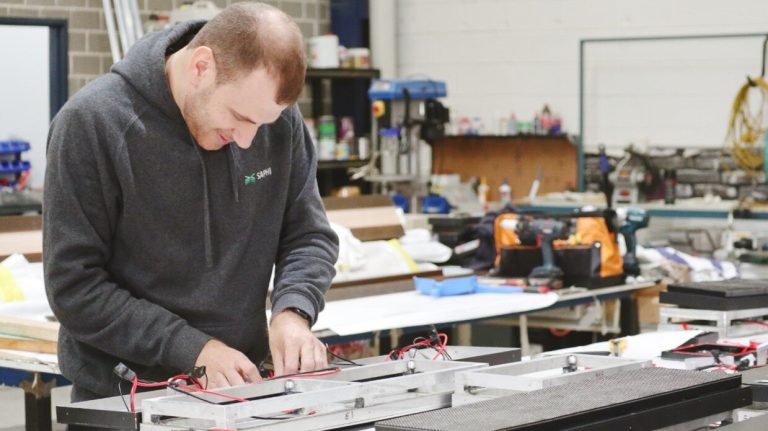IoT and Big Data at the Edge

As part of our Galaxy Ecosystem Program, we invite our customers to write articles for us to share on our site. This article was written by Liam Manning, COO of SAPHI Engineering, a Newcastle-based end-to-end IoT product development and systems integration company. They help clients design, build & integrate smart solutions interconnected via the Internet. SAPHI is a member of the Leading Edge Data Centres Ecosystem.
IoT and Big Data are two terms regularly cited but rarely explained in terms of tangible benefits they can bring your business. In this article, the team at SAPHI break down these complex topics and highlight relevant examples of how you can leverage this power-duo to align your business with the next technical shift.
Creating Value out of Your Data
IoT is a powerful connector linking devices, humans, places and assets together. Propelled forward by sensors, powerful embedded electronics and high-speed connectivity, IoT is disrupting the already evolving value chains we recognise today. Another powerful driving force of IoT that has garnered incredible amounts of media attention in recent years and is central to our article today is Big Data which represents the mass amounts of data streaming in from IoT devices at high velocity in a variety of formats.
In terms of a spectrum of value, with instant value at one end and long-term value at the other, we can visualise IoT and Big Data like this:

IoT Explained

IoT provides instantaneous value to your business and city. For example, do you want to see the real-time performance of an asset? Airborne particles in the environment? The health of waterways? You can receive this meaningful data with the right devices and, most importantly, the right integration team to ensure these devices are configured, and the data is fed into your systems correctly.
Big Data Explained

Big Data, on the other hand, is an investment. It allows you to play the long game and unlock latent value, recognized only when enough data points have been collected from IoT device for finding correlations. For example, can we predict when an asset will fail? Does the number of health complaints increase when certain particle levels are higher? What factors indicate that the health of waterways are deteriorating, and what can we do to help?
Use Cases: How Companies are Using IoT and Big Data to drive Business Value
The datafication of businesses and cities are presenting completely new opportunities for innovation, providing the public with superior value faster, easier and smarter.
But it is not the data collected nor the parameters measured that peak interest, it is the outcomes from these actions we are interested in. The following are three examples our team at SAPHI have been part of in the past 12 months.
Example 1: Fleet management
Problem – Having to manually manage and track the health of assets such as trucks and machinery.
Solution – Extraction of data from assets and integration into a new AI predictive analytics system we partner with to predict problems before they occur.
Outcomes:
-
Freeing up staff to focus on opportunities and value creation activities rather than on completing manual maintenance processes
-
Increased life span of assets
-
Increased utilisation of assets
-
Time and money saved
Example 2: Weather monitoring
Problem – Difficulty monitoring localised weather patterns
Solution – Fully integrated IoT weather system and dashboard to monitor 50 separate weather parameters.
Outcomes:
-
Weather pattern analysis
-
Solar output predictions
-
Prediction of asset damage
-
Identification of localised heat islands
Example 3: Waterway monitoring
Problem – Struggling to monitor quality of water
Solution – Development of pH, Turbidity and water level systems that alert users when levels pass predetermined limits.
Outcomes:
-
Remote monitoring
-
Freeing up staff from manual processes
-
Efficient maintenance
Addressing the Challenges of IoT and Big Data
While IoT produces data which can provide valuable insights for an organisation, there are a number of considerations which companies should address when implementing IoT devices. Here are some tips that you can use when you set up IoT within your company:
1. Begin with the end in mind: Putting sensors in the wrong places could mean that you collect more data than you require, and some sensors could prove to be providing irrelevant data. By sharing your desired outcomes with your IoT company, they will be able to design the right sensors for your company to ensure you get your return on investment.
2. Data ownership: Once the data becomes available to your business, it needs to be addressed by the business to understand what it means and to create actionable insights. You will want to give ownership to one person within the business who works with the other stakeholders to drive decisions.
3. Use a secure environment: The data your sensors create is sensitive, and one of the biggest issues faced by analytics is the constant breach incidents on devices as IoT and Big Data solutions can be prone to security attacks. It’s important to make sure your sensors are secure and your data is stored and managed in a secure environment with a trusted host.
Improving Outcomes for Businesses and Communities
IoT and big data are primed and ready to extract new forms of value, automate tedious manual tasks and free up the workforce to focus on value creation activities that will bring positive change to our communities. To find out more, feel free to give our team at SAPHI a call anytime. Please follow SAPHI’s business page on Linkedin: https://www.linkedin.com/company/saphi-engineering/









